DOI:
10.1039/C7RA11548B
(Paper)
RSC Adv., 2017,
7, 54142-54152
Poly(acrylonitrile-co-2-methylenesuccinamic acid) as a potential carbon fiber precursor: preparation and stabilization
Received
19th October 2017
, Accepted 20th November 2017
First published on 24th November 2017
Abstract
A novel bifunctional comonomer 2-methylenesuccinamic acid (MLA) was synthesized to prepare poly(acrylonitrile-co-2-methylenesuccinamic acid) [P(AN-co-MLA)] copolymers, which can improve the stabilization of polyacrylonitrile significantly as a carbon fiber precursor. The structure and stabilization of P(AN-co-MLA) copolymers with different monomer feed ratios of AN/MLA were characterized by elemental analysis (EA), Fourier transform infrared spectroscopy (FTIR), X-ray diffraction (XRD) and differential scanning calorimetry (DSC). Reactivity ratio studies shows that MLA possesses higher reactivity than AN, resulting in higher MLA content in P(AN-co-MLA) copolymers than in the feed. The molecular weight and conversion of copolymer decrease gradually with the increase of MLA content in the feed. Comparing with PAN homopolymer, P(AN-co-MLA) copolymer has two or even three exothermic peaks, and the initial temperature of P(AN-co-MLA) copolymer is ca. 70 °C lower than that of PAN, which broadens the exothermic peak. The ΔH/ΔT reduces from 34.01 J g−1 °C−1 to less than 17.67 J g−1 °C−1, confirming that the incorporation of MLA can avoid centralized heat release effectively. In addition, the extent of stabilization increases as the MLA content in P(AN-co-MLA) copolymer increases under the same heat treatment conditions. The activation energy (Ea) calculation shows cyclization Ea of P(AN-co-MLA) reduces from ca. 168 kJ mol−1 to ca. 110 kJ mol−1, it is concluded that synthesized comonomer MLA can significantly improve stabilization of PAN, which is conducive to the preparation of high performance carbon fiber.
1. Introduction
Carbon fiber is a high-performance reinforcing material, which possesses excellent properties such as high strength, high modulus, good heat resistance and electrical conductivity.1,2 The composites of carbon fiber have been applied in many areas, such as transportation, architecture, the medical industry, sports equipment, defense areas and high-tech aerospace.3–5 At present, three precursors, polyacrylonitrile fibers, pitch fibers and viscose fibers, can be employed to produce carbon fibers in industry, where polyacrylonitrile fibers are in a dominant position. However, polyacrylonitrile (PAN) homopolymer can't be used to prepare high strength carbon fiber in industry, owing to its poor stabilization such as high initiation temperature and rapid heat release. Thermal stabilization of PAN fibers is the key step in the production of carbonfibers.6–8 Usually, a small amount of acidic comonomer, such as acrylic acid,9 methacrylic acid10 and itaconic acid (IA),11 was incorporated into a polymer chain to improve the stabilization of PAN homopolymer. Acid monomers can reduce the initiation temperature of stabilization and broaden the exothermic peak through ionic mechanism.12–14 What's more, the activation energy (Ea) of stabilization can be reduced significantly. Among acidic comonomers, IA is the most used one because it contains two carboxyl groups (–COOH) which can initiate the intermolecular and intramolecular cyclization through ionic mechanism. The initiation temperature of cyclization has been reduced from 240 °C to 180 °C.15,16 The cyclization Ea of P(AN-co-IA) has been splitted into two parts, the first part is assigned to ionic mechanisms about 104 kJ mol−1, which is much smaller than that of PAN homopolymer (130 kJ mol−1).22,23 The amount of IA can be reduced compared with other comonomer containing only one carboxy group, which is beneficial to preparing high performance carbon fiber. However, the carboxyl group of IA can capture the free radicals during polymerization process, resulting in the decrease of molecular weight, which limits the improvement of tensile strength of final carbon fiber. The acrylamide (AM) comonomer was also employed to improve the stabilization of PAN in many literatures,17–20 since the nitrogen of amide group (–CONH2) can make a nucleophilic attack on adjacent carbon atoms of nitrile group, which can initiate the cyclization of PAN polymers at lower temperature through ionic mechanism and broaden the exothermic peaks.16,21
It is known that high molecular weight polyacrylonitrile precursor is the prerequisite for preparation of high performance carbon fiber.21–24 In this work, a bifunctional comonomer 2-methylenesuccinamic acid (MLA) with carboxyl group and amide group was synthesized to prepare poly(acrylonitrile-co-2-methylenesuccinamic acid) [P(AN-co-MLA)]. Compared with IA, the amide group of the MLA replaces one of the carboxyl groups, which can reduce the probability of chain termination during polymerization process and improve molecular weight of PAN polymer effectively.25 The effects of monomer feed ratio on polymerization, polymer structure and stabilization were studied by elemental analysis (EA), Fourier transform infrared spectroscopy (FTIR), X-ray diffraction (XRD) and differential scanning calorimetry (DSC) in detail.
2. Experimental
2.1 Materials
Acrylonitrile (AN, analytical grade) was purchased from Shanghai Boer Chemical Reagent Co., Ltd. Shanghai, China. AN was distilled twice and stored in refrigerator before polymerization. Azodiisobutyronitrile (AIBN, analytical grade) was provided commercially by Sinopharm Chemical Reagent Co., Ltd. Shanghai, China and recrystallized twice by methanol. Dimethyl sulfoxide (DMSO, analytical grade) was received from Shanghai Huadong Reagent Company, Shanghai, China. 2-Methylenesuccinamic acid (MLA) was synthesized in our laboratory. Itaconic acid (IA) and ammonium hydroxide (28 wt%, analytical grade) were commercially supplied by Sinopharm Chemical Reagent Co., Ltd. Shanghai, China.
2.2 Synthesis of bifunctional comonomer MLA
154 g ammonium hydroxide (28 wt%) was added into a 1 L round-bottomed flask equipped with a mechanical stirrer. 98 g of IA was added slowly to the solution after cooling to 0 °C, keeping the reaction temperature below 5 °C. The mixture was warmed to room temperature when the addition of IA was completed. After stirring for 2 h the reaction mixture was cooled to 0 °C and the pH of it was adjusted to below 1 by adding 4 M H2SO4 dropwise. After stirring for another 18 h under room temperature, the slurry was filtrated through a sintered glass frit at 0 °C and washed with 100 mL of dilute H2SO4 (pH < 3). The crude MLA was recrystallized by ethanol (120 mL) to get crystal.
Crystal, 52.7% yield. IR (KBr) νmax cm−1: 3359, 3200 (N–H2), 2934, 2901 (C–H), 1704 (C![[double bond, length as m-dash]](https://www.rsc.org/images/entities/char_e001.gif) O), 1668 (C
O), 1668 (C![[double bond, length as m-dash]](https://www.rsc.org/images/entities/char_e001.gif) O), 1640 (C
O), 1640 (C![[double bond, length as m-dash]](https://www.rsc.org/images/entities/char_e001.gif) C), 1433 (δ C–H), 1282, 1170 (C–O). 1H-NMR (400 Hz, DMSO-d6, RT, TMS) δ ppm: 12.39 (s, 1H, COOH), 7.26, 6.79 (s, 2H, H2N), 6.09 (d, J = 0 Hz, 1H, CH2
C), 1433 (δ C–H), 1282, 1170 (C–O). 1H-NMR (400 Hz, DMSO-d6, RT, TMS) δ ppm: 12.39 (s, 1H, COOH), 7.26, 6.79 (s, 2H, H2N), 6.09 (d, J = 0 Hz, 1H, CH2![[double bond, length as m-dash]](https://www.rsc.org/images/entities/char_e001.gif) ), 5.64 (d, J = 0 Hz, 1H, CH2
), 5.64 (d, J = 0 Hz, 1H, CH2![[double bond, length as m-dash]](https://www.rsc.org/images/entities/char_e001.gif) ), 3.07 (s, 2H, CH2).
), 3.07 (s, 2H, CH2).
2.3 Preparation of P(AN-co-MLA)
P(AN-co-MLA) copolymer with different feed ratio of AN/MLA = 99/1, 98/2, 97/3, 96/4, 95/5 (wt/wt) was prepared at 60 °C under nitrogen atmosphere using DMSO as solvent and AIBN as initiator. The monomer concentration was 24 wt% and initiator content was 0.8 wt% of monomer. A typical polymerization for feed ratio AN/MLA = 99/1 (wt/wt) is given below: 10.00 mL of AN, 0.1966 g of MLA, 23.60 mL of DMSO and 0.0656 g of AIBN were added into a 250 mL three-necked flask fitted with a condenser tube and stirrer. After 24 hours of polymerization, the reaction mixture was poured into excessive methanol to precipitate the polymer. The isolated polymer was washed with methanol for 4–5 times and then dried at 60 °C under vacuum to a constant weight. For comparison, PAN homopolymer and poly(acrylonitrile-methyl acrylate-acrylic acid) [P(AN-MA-AA)] with feed ratios AN/MA/AA = 98/2/2 was also prepared by solution polymerization in this work.
2.4 Characterization
Fourier transform infrared spectroscopy (FTIR) spectra was recorded on a Nicolet 8700 FTIR spectrophotometer at room temperature using transmission method; 1 mg powder sample was mixed thoroughly with 100 mg KBr and pelletized for FTIR characterization; 32 scans were collected at a resolution of 1 cm−1 and the wavelength region is 400 to 4000 cm−1.
DSC curves were carried out on a Modulated DSC 2910. Five metals (In, Hg, Sn, Bi, Zn) was employed for temperature and heat flow calibrations. The melting point of metals was used for temperature calibration and the melting area was used for heat flow calibration. 5–10 mg samples were scanned at different heating rates (i.e. 5, 10, 15, 20, 30 °C min−1) in N2 atmosphere (40 mL min−1).
Elementar vario EL III elemental analyzer was employed to determine the content of carbon (C), nitrogen (N), hydrogen (H) and oxygen (O) of P(AN-co-MLA) copolymers.
The monomer reactivity ratios were calculated from the element analysis results.
X-ray diffraction (XRD) patterns of powered samples were measured on a Rigaku D/max-2550 diffractometer using nickel-filtered Cu K-α radiation (wavelength: 0.154 nm) in the range 3–50° at the rate of 1° min−1. The current and voltage values is 200 mA and 40 kV, respectively. All the XRD measurements were carried out under the same conditions. The crystalline planar spacing d and crystallite size of the laterally order domains (Lc) were estimated by the Scherrer equation and Bragg equation as follows:26
| |
 | (1) |
| |
 | (2) |
where
λ = 0.154056 nm is the wavelength of CuK
α X-ray,
θ is the Bragg angle,
B is the full width at half maximum intensity (FWHM) of the peak around 2
θ = 17°, and
k is a constant 0.89. The crystallinity (CI) was determined by Bell and Dumbleton method:
26| |
 | (3) |
where
Ac is the integral area of crystalline zone around2
θ = 17° in XRD patterns, and
Aa is the integral area of amorphous zone.
Ac was calculated using straight line segments from 2
θ = 11° to 2
θ = 21° as the baseline, while the total integral area
A (
A = (
Ac +
Aa)) using straight line segments from 2
θ = 11° to 2
θ = 32° as the baseline.
The viscosity-average molecular weight (Mη) of the P(AN-co-MLA) copolymers was measured in a (50 ± 0.5) °C water bath using Ubbelohde viscometer method as follows: 0.20 g of P(AN-co-MLA) copolymer was dissolved in 15 mL DMSO solvent. 10 mL of P(AN-co-MLA) solution was injected into Ubbelohde viscometer, the efflux time of P(AN-co-MLA) solution was measured and named as t1. Then, 5 mL of DMSO was added into the above P(AN-co-MLA) solution, measuring the efflux time t2 of mixture. The efflux time t3, t4, t5 was obtained by adding 10 mL, 10 mL, 10 mL DMSO solvent in Ubbelohde viscometer. The equation is expressed as follows:
| |
 | (4) |
| |
 | (5) |
where
t0 is the efflux time of the DMSO,
ηr is relative viscosity,
ηsp is specific viscosity. A series of ln(
ηr/
c) and
ηsp/
c were calculated at different concentrations (
c). The plots of ln(
ηr/
c)
versus c and
ηsp/
c versus c give straight lines. The intrinsic viscosity [
η] is calculated by linear extrapolation of
c to zero. The viscosity average molecular weight
Mη was determined by the following equation:
| | |
[η] = 2.83 × 10−2Mη0.758
| (6) |
For heat treatment, the power sample was heated at different temperatures in an air oven with a temperature accuracy of 1 °C. First, the air oven was heated to the setting temperatures (i.e. 160, 180, 185, 200, 220, 240, 260, 280 °C), then the powder samples were put into the air oven and heated at the constant temperature for 30 min.
3. Results and discussion
3.1 The molecular weight and conversion rate
The effect of monomer feed ratio (AN/MLA) on the polymerization conversion and the molecular weight of P(AN-co-MLA) is shown in Fig. 1. As MLA content in the monomer feed ratio increases, both the polymerization conversion and molecular weight of P(AN-co-MLA) reduce significantly. The molecular volume and steric hindrance of MLA are larger than that of AN, which impedes propagating of chain radicals and results in the decrease of molecular weight and conversion.8 It is well known that the molecular weight of acrylonitrile copolymers has a significant effect on the properties of carbon fibers. In order to get high molecular weight P(AN-co-MLA), the amounts of comonomer in the feed should be controlled less than 3.0 wt% based on total monomers.27
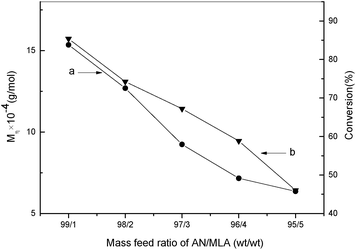 |
| | Fig. 1 Effect of monomer feed ratio on the conversion of polymerization and molecular weight: (a) molecular weight, (b) the conversion rate. | |
3.2 Reactivity ratio studies
According to the mechanism of free radical polymerization, the molar fraction of MLA in P(AN-co-MLA) can be calculated by the following equation with the end-group effect on the polymer ignored:| |
 | (7) |
where CO is the oxygen content of P(AN-co-MLA) copolymers. From the elemental analysis of oxygen, the molar fraction ratios of AN/MLA in the P(AN-co-MLA) copolymers can be obtained, which is used to calculate the reactivity ratio of AN and MLA by Fineman–Rossand Kelen–Tüdõs methods. Table 1 shows parameters for solution copolymerization of AN/MLA under low conversion.
Table 1 Parameters for solution copolymerization of AN/MLA under low conversion
| AN/MLA in the feed (wt/wt) |
Xa (mol mol−1) |
Conversion (%) |
O content in the copolymers (wt%) |
Yb (mol mol−1) |
| X = [M1]/[M2]. Y = d[M1]/d[M2]. |
| 99/1 |
240.89 |
5.34 |
0.648 |
137.328 |
| 98/2 |
119.22 |
6.28 |
1.291 |
67.718 |
| 97/3 |
78.67 |
5.52 |
1.919 |
44.760 |
| 96/4 |
58.39 |
5.43 |
2.548 |
33.110 |
| 95/5 |
46.23 |
6.09 |
3.162 |
26.208 |
According to the Mayo–Lewis equation, the Fineman–Ross method is depicted as follows:
G and
H are represented by
where
X and
Y are the molar fraction ratios of AN/MLA in the feed and in the P(AN-
co-MLA) copolymers, respectively:
| | |
X = [M1]/[M2] and Y = d[M1]/d[M2]
| (10) |
The plot of G versus H gives a straight line with the slope as r1 and the intercept of the Y axis as r2.
The equations proposed by Kelen and Tüdõs method are expressed as follows:
| |
 | (11) |
η and
ξ are represented by
| | |
η = G/(α + H) and ξ = H/(α + H)
| (12) |
α is an arbitrary constant and represented by
where
Hm and
HM is the lowest and highest values calculated from the series of measurements. The plot of
η versus ξ gives a straight line. The extrapolation of the line to
ξ = 1 gives
r1 and to 0 gives
r2/
α.
As shown in the Fig. 2, the reactivity ratios computed by Fineman–Ross agrees well with that obtained by Kelen–Tüdõs and the reactivity ratio of MLA is larger than that of AN, indicating that the reactivity of comonomer MLA is higher than that of AN. Therefore, more comonomer MLA is incorporated into the polymer chain than AN. Which was confirmed by the following elemental results that the content of MLA in the P(AN-co-MLA) copolymer is higher than in the feed.28,29
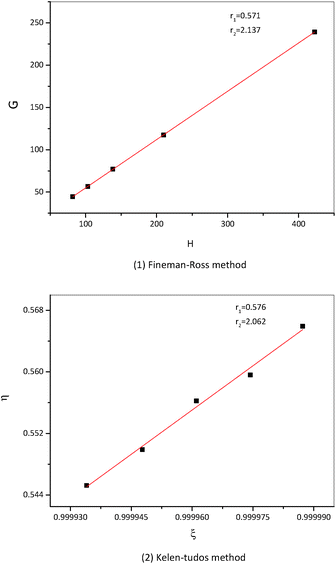 |
| | Fig. 2 Fineman–Ross (1) and Kelen–Tüdõs (2) methods used to calculate monomer reactivity ratios. | |
3.3 Elemental analysis
The acetanilide was used as a standard to analyze the elemental content of [P(AN-co-MLA)] copolymers. Two readings were obtained during the collection of elemental analysis data and the standard deviation is less than 3‰. Fig. 3 shows the elemental analysis of the P(AN-co-MLA) copolymers with different feed ratios of AN/MLA. The O content in P(AN-co-MLA) becomes larger with the increase of MLA content in the feed, manifesting the increase of MLA content in P(AN-co-MLA), because the O element is only provided by the comonomer MLA. However, all other element C, N and H contents decrease with the increase of MLA content in the feed. In addition, the O content in the feed (Of) is also shown, it can be found that the O content in P(AN-co-MLA) copolymer is larger than Of, indicating that more MLA was incorporated in the polymer chains than in the feed, which is consistent with the above reactivity ratio results.30
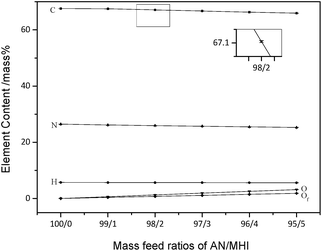 |
| | Fig. 3 Elemental analysis of P(AN-co-MLA) copolymers with different feed ratios of AN/MLA![[thin space (1/6-em)]](https://www.rsc.org/images/entities/char_2009.gif) : :![[thin space (1/6-em)]](https://www.rsc.org/images/entities/char_2009.gif) Of, O content in the feed. Of, O content in the feed. | |
3.4 FTIR studies
Fig. 4(1) shows the FTIR spectra of PAN and P (AN-co-MLA) copolymer with different mass feed ratios. The peak at 2244 cm−1 is assigned to the stretching vibration of C![[triple bond, length as m-dash]](https://www.rsc.org/images/entities/char_e002.gif) N acrylonitrile unit in the polymer chain. The peak at 1721 and 1678 cm−1 belong to stretching vibration of C
N acrylonitrile unit in the polymer chain. The peak at 1721 and 1678 cm−1 belong to stretching vibration of C![[double bond, length as m-dash]](https://www.rsc.org/images/entities/char_e001.gif) O and amide groups, respectively.31,32 Obviously, the C
O and amide groups, respectively.31,32 Obviously, the C![[double bond, length as m-dash]](https://www.rsc.org/images/entities/char_e001.gif) O and NH2 groups only exist in the MLA comonomer, the appearance of 1721 cm−1 and 1678 cm−1 peaks in Fig. 4(1)(b)–(d) indicates the comonomer MLA copolymerizes with AN successfully. The intensity of peak at 1721 cm−1 and 1678 cm−1 becomes larger with the increase of MLA content in the feed, indicating more MLA was incorporated in the polymer chains. The content of MLA in P(AN-co-MLA) copolymer can be controlled by the monomer feed ratio. For all P(AN-co-MLA) copolymer, the intensity of peak at 2244 cm−1 attributed to C
O and NH2 groups only exist in the MLA comonomer, the appearance of 1721 cm−1 and 1678 cm−1 peaks in Fig. 4(1)(b)–(d) indicates the comonomer MLA copolymerizes with AN successfully. The intensity of peak at 1721 cm−1 and 1678 cm−1 becomes larger with the increase of MLA content in the feed, indicating more MLA was incorporated in the polymer chains. The content of MLA in P(AN-co-MLA) copolymer can be controlled by the monomer feed ratio. For all P(AN-co-MLA) copolymer, the intensity of peak at 2244 cm−1 attributed to C![[triple bond, length as m-dash]](https://www.rsc.org/images/entities/char_e002.gif) N stretching vibration keeps unchanged, suggesting that long uninterrupted sequences of AN unit are present in polymer chains of all P(AN-co-MLA) copolymers. The intensity of bending vibration (1454 cm−1) of CH2 and stretching vibration (2939 cm−1) of CH, CH2 groups do not show obvious changes.
N stretching vibration keeps unchanged, suggesting that long uninterrupted sequences of AN unit are present in polymer chains of all P(AN-co-MLA) copolymers. The intensity of bending vibration (1454 cm−1) of CH2 and stretching vibration (2939 cm−1) of CH, CH2 groups do not show obvious changes.
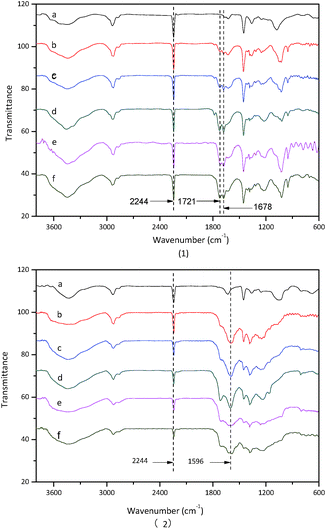 |
| | Fig. 4 FTIR spectra of PAN and P(AN-co-MLA) copolymers with different feed ratios (1) original and (2) stabilized 185 °C for 30 minutes: (a) PAN, (b) AN/MLA = 99/1 (wt/wt), (c) AN/MLA = 98/2 (wt/wt), (d) AN/MLA = 97/3 (wt/wt), (e) AN/MLA = 96/4 (wt/wt), (f) AN/MLA = 95/5 (wt/wt). | |
Fig. 4(2) show FTIR spectra of PAN and P(AN-co-MLA) copolymers with different compositions stabilized at 185 °C for 30 minutes in air atmosphere. It is well known that a few exothermic reactions occur during stabilization process, such as cyclization, dehydrogenation and oxidation. The cyclization reactions convert C![[triple bond, length as m-dash]](https://www.rsc.org/images/entities/char_e002.gif) N structure into the C
N structure into the C![[double bond, length as m-dash]](https://www.rsc.org/images/entities/char_e001.gif) N structure and dehydrogenating reactions convert C–C structure into C
N structure and dehydrogenating reactions convert C–C structure into C![[double bond, length as m-dash]](https://www.rsc.org/images/entities/char_e001.gif) C structure, which are the most important two reactions for preparation of high performance carbon fiber. As shown in Fig. 4(2), the intensity of peak at 2244 cm−1 (stretching vibration of C
C structure, which are the most important two reactions for preparation of high performance carbon fiber. As shown in Fig. 4(2), the intensity of peak at 2244 cm−1 (stretching vibration of C![[triple bond, length as m-dash]](https://www.rsc.org/images/entities/char_e002.gif) N) decreases with the increase of MLA content in the feed, confirming more C
N) decreases with the increase of MLA content in the feed, confirming more C![[triple bond, length as m-dash]](https://www.rsc.org/images/entities/char_e002.gif) N structure convert into C
N structure convert into C![[double bond, length as m-dash]](https://www.rsc.org/images/entities/char_e001.gif) N structure and the synthesized comonomer MLA can improve effectively the cyclization reaction. The peak at 1596 cm−1 is assigned to stretching vibration bands of C
N structure and the synthesized comonomer MLA can improve effectively the cyclization reaction. The peak at 1596 cm−1 is assigned to stretching vibration bands of C![[double bond, length as m-dash]](https://www.rsc.org/images/entities/char_e001.gif) C (due to dehydrogenation reaction) conjugated with C
C (due to dehydrogenation reaction) conjugated with C![[double bond, length as m-dash]](https://www.rsc.org/images/entities/char_e001.gif) N (due to cyclization reaction). As MLA content increases in the feed, the intensity of conjugated stretching bands strengthens. This means both cyclization and dehydrogenation have been promoted by the comonomer MLA. In order to evaluate the extent of stabilization, the parameter was defined by using intensity changes of bonds at 2244 cm−1 and 1596 cm−1 as follows:11
N (due to cyclization reaction). As MLA content increases in the feed, the intensity of conjugated stretching bands strengthens. This means both cyclization and dehydrogenation have been promoted by the comonomer MLA. In order to evaluate the extent of stabilization, the parameter was defined by using intensity changes of bonds at 2244 cm−1 and 1596 cm−1 as follows:11
| | |
Es = A1596 cm−1/A2244 cm−1
| (14) |
where
A is the absorbance intensity defined as
A = log(
T0/
T),
T0 and
T are the transmittances at baseline and maximum, respectively. According to Lambert–Beer's law:
A =
abc, where
a is the molar absorption coefficient,
b is the thickness of the KBr pellet, and
c is the molar concentration of sample solution. Both the absorbance intensity of bands at 2244 cm
−1 and 1596 cm
−1 are determined by using the same sample, namely with the same
b value. Therefore, the intensity ratio of the two absorption peaks at 1596 cm
−1 and 2244 cm
−1 is approximately equal to the ratio of the content of the generated C
![[double bond, length as m-dash]](https://www.rsc.org/images/entities/char_e001.gif)
N and C
![[double bond, length as m-dash]](https://www.rsc.org/images/entities/char_e001.gif)
C to the residual C
![[triple bond, length as m-dash]](https://www.rsc.org/images/entities/char_e002.gif)
N group.
The MLA/AN (wt/wt) in P(AN-co-MLA) was calculated based on the element analysis above. The effect of MLA/AN (wt/wt) in P(AN-co-MLA) on the extent of stabilization (Es) is shown in Fig. 5. The extent of stabilization increases significantly with the increase of MLA content in the P(AN-co-MLA) copolymer. The cyclization reaction of P(AN-co-MLA) copolymer can be initiated by free radical mechanism and ionic mechanism, because the carboxyl oxygen and amide nitrogen of in MLA comonomer can make nucleophilic attack on the carbon atom of an adjacent nitrile group and then induce molecules to cyclize.33 The bifunctional comonomer MLA provides nitrile groups with more opportunities to cyclize than PAN homopolymer through ionic mechanism, thus the Es values becomes larger with increase of MLA content in the P(AN-co-MLA).
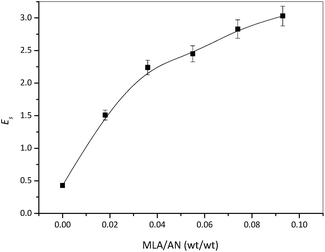 |
| | Fig. 5 Effect of MLA/AN (wt/wt) in P(AN-co-MHI) on the extent of stabilization (Es). | |
3.5 XRD studies
Fig. 6(1) shows the XRD patterns of P(AN-co-MLA) copolymers with different feed ratios. There are two peaks in the XRD patterns, a stronger diffraction peak at about 2θ = 17° assigned to (100) crystalline plane of the pseudohexagonal cell and a weak diffraction peak at about 2θ = 29° assigned to the (101) crystalline plane of the pseudohexagonal cell.34 The intensity of peak (2θ = 17°) decreases with the increase of MLA content in P(AN-co-MLA) copolymers because of the incorporation of MLA into polymer chains. XRD patterns of P(AN-co-MLA) were processed by Origin 8.5 software to analyze the peak center, peak area and the FWHM of peak around 2θ = 17°. The crystalline planar spacing d, crystallite size Lc and crystallinity CI was calculated and summarized in Table 2. The crystallinity index CI of the P(AN-co-MLA) copolymer is smaller than that of PAN homopolymer (50.24%) reported in our previous work,35 and decreases with the increase of MLA content in P(AN-co-MLA) copolymer. The reason is that the incorporation of MLA into polymer chain blocks the interaction between C![[triple bond, length as m-dash]](https://www.rsc.org/images/entities/char_e002.gif) N groups and as a result of reducing form of CI. The XRD patterns of P(AN-co-MLA) heated at 185 °C for 30 minutes in an air atmosphere are shown in Fig. 6(2). The stabilization is a process that converting linear structure to ladder structure, and the structural changes during the stabilization agree well with the intensity changes of the peak around 2θ = 17°.36 Thus, the peak intensity around 2θ = 17° can be used to represent the extent of stabilization, the formula is as follows:37where I0 is the intensity of peak around 2θ = 17° from the original polymer, and Is is the intensity of peak around 2θ = 17° from the polymer stabilized for 30 min.
N groups and as a result of reducing form of CI. The XRD patterns of P(AN-co-MLA) heated at 185 °C for 30 minutes in an air atmosphere are shown in Fig. 6(2). The stabilization is a process that converting linear structure to ladder structure, and the structural changes during the stabilization agree well with the intensity changes of the peak around 2θ = 17°.36 Thus, the peak intensity around 2θ = 17° can be used to represent the extent of stabilization, the formula is as follows:37where I0 is the intensity of peak around 2θ = 17° from the original polymer, and Is is the intensity of peak around 2θ = 17° from the polymer stabilized for 30 min.
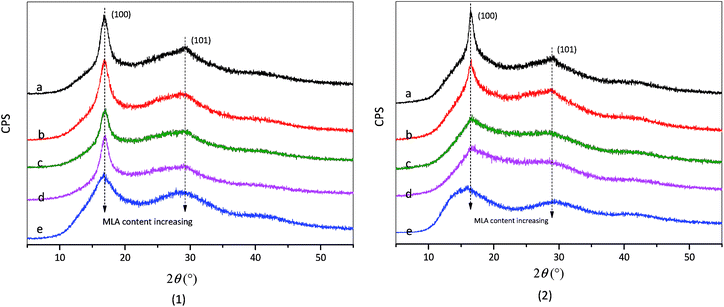 |
| | Fig. 6 XRD patterns of P(AN-co-MLA) copolymers with different MLA/AN compositions (1) original and (2) stabilized 185 °C for 30 minutes: (a) MLA/AN = 0.018 (wt/wt), (b) MLA/AN = 0.036 (wt/wt), (c) MLA/AN = 0.055 (wt/wt), (d) MLA/AN = 0.074 (wt/wt), (e) MLA/AN = 0.093 (wt/wt). | |
Table 2 XRD analysis results of P(AN-co-MLA) copolymers with different compositions according to Fig. 6a
| MLA/AN in polymers (wt/wt) |
Peak (°) |
Peak intensity (CPS) |
FWHW (°) |
d (nm) |
Lc (nm) |
CI (%) |
| where FWHM is the full width at half maximum intensity. d is the crystalline planar spacing. Lc is crystallite size of the laterally order domains. CI is the crystallinity of P(AN-co-MLA) copolymers. |
| 0.018 |
16.89 |
718 |
0.893 |
0.530 |
9.193 |
46.94 |
| 0.036 |
17.01 |
540 |
0.898 |
0.526 |
9.148 |
45.67 |
| 0.055 |
16.89 |
487 |
0.862 |
0.530 |
9.524 |
43.93 |
| 0.074 |
16.62 |
458 |
0.950 |
0.539 |
8.629 |
42.07 |
| 0.093 |
16.72 |
259 |
0.697 |
0.536 |
11.768 |
41.94 |
As shown in Table 3, the SI value (−8.36%) of P(AN-co-MLA) with MLA/AN = 0.018 is negative, the similar as PAN (−113.56%) in our previous work.38 From the following DSC analysis (DSC studies section), it is known that the stabilization reactions of PAN homopolymer and P(AN-co-MLA) with MLA/AN = 0.018 have not yet started significantly at 185 °C, however the energy provided by heating is enough to break the boundaries between crystalline zones and amorphous zones, which results in further crystallization of P(AN-co-MLA) and the increase of intensity of (100) peak, so the SI value of PAN is negative. Although the SI for P(AN-co-MLA) with MLA/AN = 0.018 is negative, it is much larger than that of PAN, confirming the improvement of stabilization by MLA. When the MLA/AN is larger than 0.0036, the SI is positive and the stabilization dominate the intensity of peak around 2θ = 17° rather than crystallization, because the MLA can reduce significantly the cyclization initiation temperature as shown in following DSC curves. When more MLA incorporating the polymer chain of PAN, the SI become smaller due to the large molecular volume of MLA.
Table 3 SI results P(AN-co-MLA) copolymers with different compositions corresponding to Fig. 6
| MLA/AN in polymers (wt/wt) |
Peak (°) |
Peak intensity I0 (CPS) |
Peak intensity Is (CPS) |
SI (%) |
| 0.018 |
16.43 |
718 |
778 |
−8.36 |
| 0.036 |
16.58 |
540 |
472 |
12.59 |
| 0.055 |
16.21 |
487 |
142 |
70.84 |
| 0.074 |
16.65 |
458 |
155 |
66.16 |
| 0.093 |
14.83 |
259 |
112 |
56.76 |
In order to study the effect of heating temperature on stabilization of P(AN-co-MLA). The P(AN-co-MLA) copolymer with MLA/AN = 0.036 was stabilized at different temperature for 30 min and the XRD patterns of them are shown in Fig. 7. The SI was calculated using eqn (15) based on Fig. 7 and compiled in Table 4. When the heating temperature is lower than 200 °C, the stabilization has not yet started obviously, the SI is negative due to the further crystallization of P(AN-co-MLA). The heating temperature is ≥200 °C, the peak intensity of 2θ = 17° decrease significantly, the peak around 2θ = 29° disappears and a new diffracting diffraction peak about 2θ = 25.5° appears, all these phenomena confirming the polymer chains of P(AN-co-MLA) have been converted from linear structure to ladder structure. The SI has a great rise at 200 °C, after this the Is increases slowly, indicating that most of the stabilization reactions have been completed under 200 °C for 30 min. The reason is that the cyclization initiation temperature of P(AN-co-MLA) has been reduced greatly from 244.16 °C to 176.49 °C compared with PAN homopolymer, which can be found in the following DSC studies.
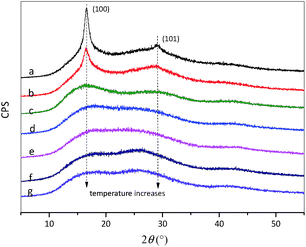 |
| | Fig. 7 XRD patterns of P(AN-co-MLA) copolymers with MLA/AN = 0.036 (wt/wt) at different temperatures for 30 minutes (a) 160 °C, (b) 180 °C, (c) 200 °C, (d) 220 °C, (e) 240 °C, (f) 260 °C, (g) 280 °C. | |
Table 4 SI results P(AN-co-MLA) copolymers with MLA/AN = 0.036 heated at different temperatures for 30 min corresponding to Fig. 7
| Heat treatment temperature |
Peak (°) |
Peak intensity I0 (CPS) |
Peak intensity Is (CPS) |
SI (%) |
| 160 °C |
16.58 |
540 |
1202 |
−122.59 |
| 180 °C |
16.50 |
540 |
584 |
−8.15 |
| 200 °C |
16.57 |
540 |
89 |
83.52 |
| 220 °C |
17.95 |
540 |
70 |
87.04 |
| 240 °C |
18.38 |
540 |
61 |
88.70 |
| 260 °C |
18.34 |
540 |
56 |
89.62 |
| 280 °C |
18.51 |
540 |
52 |
90.37 |
3.6 DSC studies
Fig. 8 shows the DSC curves of PAN, P(AN-MA-AA) with feed ratio of AN/MA/AA = 98/2/2 and P(AN-co-MLA) copolymers with different compositions heated from ambient temperature to 350 °C in N2 atmosphere (40 mL min−1). The parameters obtained from the exotherms, including the temperature of initiation (Ti), the temperature of termination (Tf) and their difference (ΔT = Tf − Ti), the first peak temperature (Tp1, the peak at lower temperature), the second peak temperature (Tp2, the peak at higher temperature), the third peak temperature (Tp3, the peak at highest temperature), the evolved heat (ΔH), and the velocity of evolving heat (ΔH/ΔT), are listed in Table 5.
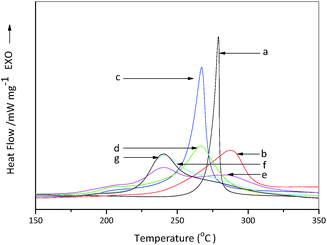 |
| | Fig. 8 DSC curves of PAN, P(AN-MA-AA) and P(AN-co-MLA) copolymers heated at 10 °C min−1. (a) PAN, (b) P(AN-AA-MA), (c) MLA/AN = 0.018 (wt/wt), (d) MLA/AN = 0.036 (wt/wt), (e) MLA/AN = 0.055 (wt/wt), (f) MLA/AN = 0.074 (wt/wt), (g) MLA/AN = 0.093 (wt/wt). | |
Table 5 Parameters for DSC curves of PAN, P(AN-AA-MA) and P(AN-co-MLA) copolymers measured under N2 atmosphere
| MLA/AN in polymers (wt/wt) |
Ti (°C) |
Tp1 (°C) |
Tp2 (°C) |
Tp3 (°C) |
Tf (°C) |
ΔT (°C) |
ΔH (J g−1) |
ΔH/ΔT (J g−1 °C−1) |
| PAN |
244.16 |
— |
— |
278.99 |
303.11 |
58.95 |
2004.67 |
34.01 |
| P(AN-AA-MA) |
203.77 |
— |
— |
285.56 |
339.05 |
135.28 |
2054.11 |
15.18 |
| 0.018 |
178.39 |
208.58 |
— |
267.25 |
305.94 |
127.58 |
2265.44 |
17.76 |
| 0.036 |
176.49 |
208.13 |
— |
266.52 |
319.53 |
143.04 |
2324.56 |
16.25 |
| 0.055 |
175.11 |
207.68 |
241.59 |
283.48 |
323.22 |
148.11 |
2226.63 |
15.03 |
| 0.074 |
174.16 |
198.96 |
241.13 |
281.02 |
340.45 |
166.29 |
2441.71 |
14.68 |
| 0.093 |
173.73 |
194.77 |
240.65 |
279.19 |
341.29 |
167.56 |
2268.84 |
13.64 |
The oxygen is absent during the DSC test, therefore no oxidation reaction occurs and the exothermic peaks of the acrylonitrile polymer is attributed to cyclization reactions.39 As shown in Fig. 8, the PAN homopolymer exhibits a sharp single exothermic peak, and the stabilization initiation temperature is as high as 244 °C. The cyclization of PAN can only be initiated through free radical mechanism at high temperature, a large amount of heat is released at a short time, which results in breakage of the molecular chain during stabilization and eventually inherits defects to the carbon fiber. Compared with PAN homopolymer, the initiation temperature of P(AN-MA-AA) decreased from 244 °C to 206 °C, and ΔH/ΔT value is reduced from 34.01 J g−1 °C−1 to 15.18 J g−1 °C−1. However, the ΔH of P(AN-MA-AA) is smaller than that of P(AN-co-MLA) as shown in Table 5, indicating fewer cyclization reaction occurs, it is not conducive to the stabilization reaction. The DSC curve of P(AN-co-MLA) copolymer has two or even three exothermic peaks, which broadens the exothermic peak and avoids the centralized heat release. The appearance of new exothermic peaks at the lower temperature is attributed to the cyclization reactions initiated by ionic mechanism. As shown in Fig. 9, both the carboxyl oxygen and amide nitrogen in MLA comonomer can make nucleophilic attack on the carbon atom of an adjacent nitrile group and then induce molecules to cyclize. There are three exothermic peaks in DSC curves c, d, e, f and g when the MLA/AN in P(AN-co-MLA) is ≥0.055 (wt/wt). The lowest one is the cyclization initiated by carboxyl oxygen attack, the higher on is the cyclization initiated by amide nitrogen attack, the highest one is the cyclization initiated by free radical. These three cyclization reactions are competitive reactions. When the MLA/AN is ≤0.036, the cyclization initiated by free radical are in the leading position.16 As the content of MLA increases, the cyclization initiated by amide nitrogen attack dominate the DSC curves.
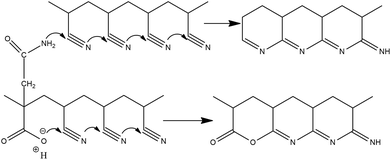 |
| | Fig. 9 Cyclization reactions initiated by MLA through ionic mechanism. | |
As shown in Table 5, the cyclization temperatures of the P(AN-co-MLA) is ca. 175 °C approximate 70 °C and 25 °C lower than that of the PAN homopolymer and P(AN-MA-AA) respectively, confirming the cyclization reactions in P(AN-co-MLA) are much easier to be initiated than in PAN and P(AN-MA-AA). And the ΔH of P(AN-co-MLA) copolymers improved by 10% or more compared with PAN and P(AN-MA-AA), suggesting more cyclization reactions occur in P(AN-MA-AA). It is beneficial to preparation of high performance carbon fiber. Obviously, MLA, which catalyzes the cyclization of nitrile groups through ionic mechanism, can improve significantly stabilization of P(AN-co-MLA). In addition, ΔH/ΔT of P(AN-co-MLA) reduces from 34.01 J g−1 °C−1 to less than 17.67 J g−1 °C−1, indicating the comonomer MLA can relax exotherm during the stabilization and avoid the centralized heat release effectively.
3.7 Evaluation of activation energy (Ea) of cyclization reactions
Fig. 10 shows DSC curves of PAN, P(AN-MA-AA) with feed ratio of AN/MA/AA = 98/2/2 (wt/wt/wt) and P(AN-co-MLA) with MLA/AN = 0.055 (wt/wt) heated at different rates (5, 10, 15, 20, 30 °C min−1) from 50 °C to 350 °C in N2 atmosphere (40 mL min−1). As the heating rate increases, the whole exothermic peaks become stronger and shift to high temperatures (Table 6). The apparent activation energy (Ea) of the cyclization reactions was calculated by Kissinger40 and Ozawa methods.41 These two methods can be used to quantify Ea without any prior knowledge of reaction mechanism but just requiring a series of DSC curves heated at different rates.42 The peak temperature (Tm), used by Kissinger and Ozawa methods to evaluate Ea, are summarized in Table 7. The Tm of DSC shows a regular increase with the increase of heating rate (φ).
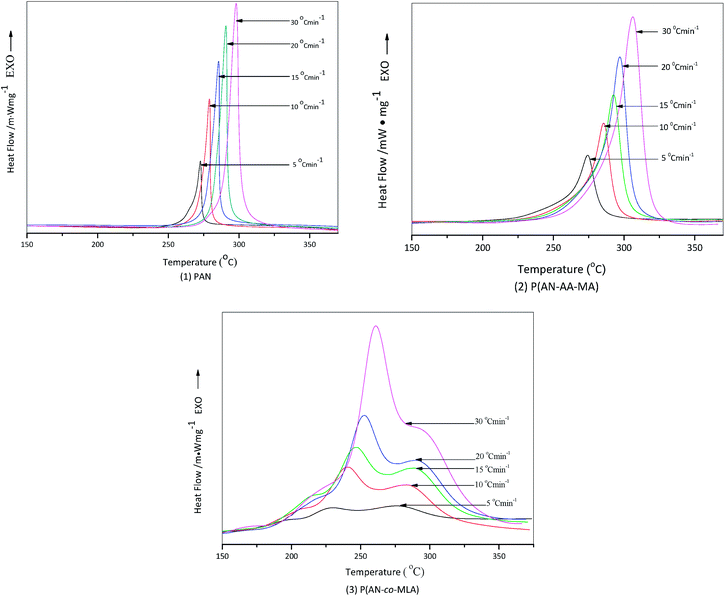 |
| | Fig. 10 DSC curves of (1) PAN, (2) P(AN-MA-AA) with feed ratio ofAN/MA/AA = 98/2/2 and (3) P(AN-co-MLA) with MLA/AN = 0.055 heated at different rate. | |
Table 6 DSC peak maxima for PAN polymers heated at different rates
| Heating rate (K min−1) |
PAN Tm (°C) |
P(AN-MA-AA) Tm (°C) |
P(AN-co-MLA) |
| Tm1 (°C) |
Tm2 (°C) |
Tm3 (°C) |
| 5 |
272.67 |
274.43 |
200.51 |
229.17 |
276.48 |
| 10 |
278.99 |
285.56 |
209.43 |
240.66 |
283.71 |
| 15 |
285.64 |
292.61 |
217.50 |
246.95 |
288.79 |
| 20 |
290.71 |
297.05 |
222.46 |
252.93 |
291.30 |
| 30 |
298.06 |
306.12 |
225.30 |
260.98 |
293.51 |
Table 7 Ea determined by Kissinger and Ozawa methods
| Method |
Peak |
PAN |
P(AN-MA-AA) |
MLA/AN in polymer = 0.018 |
MLA/AN in polymer = 0.036 |
MLA/AN in polymer = 0.055 |
MLA/AN in polymer = 0.074 |
MLA/AN in polymer = 0.093 |
| Kissinger |
Peak 1 |
168.36 |
141.49 |
115.47 |
114.79 |
123.80 |
102.36 |
101.19 |
| Peak 2 |
— |
— |
117.64 |
105.58 |
106.50 |
| Peak 3 |
168.55 |
186.13 |
227.47 |
164.53 |
156.54 |
| Ozawa |
Peak 1 |
165.89 |
140.86 |
115.40 |
114.74 |
123.16 |
102.93 |
101.85 |
| Peak 2 |
— |
— |
117.98 |
106.68 |
107.52 |
| Peak 3 |
165.83 |
182.22 |
220.94 |
162.13 |
154.73 |
The equation used by Kissinger's method are as follows:39
| |
 | (16) |
Ea was calculated from the slope of the linear plot of ln
![[thin space (1/6-em)]](https://www.rsc.org/images/entities/char_2009.gif) φ
φ/
Tm2 versus 1000/
Tm as shown in
Fig. 11(1).
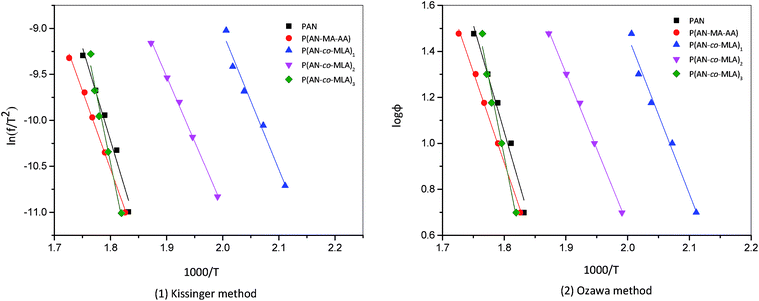 |
| | Fig. 11 Kissinger method (1) and Ozawa method (2) used to quantify Ea of PAN, P(AN-MA-AA) and P(AN-co-MLA) with MLA/AN = 0.055. | |
Ozawa's method uses the following equation:40
| |
 | (17) |
Ea was calculated from the slope of the linear plot of log
![[thin space (1/6-em)]](https://www.rsc.org/images/entities/char_2009.gif) φ versus
φ versus 1000/
Tm as shown in
Fig. 11(2).
Table 7 shows the Ea of cyclization reactions of PAN, P(AN-MA-AA) with AN/MA/AA = 98/2/2 (wt/wt/wt) and P(AN-co-MLA) copolymers with MLA/AN = 0.018, 0.036, 0.055, 0.074, 0.093 (wt/wt). The Ea determined by Kissinger method agrees well with that obtained by Ozawa method for all polymers. The Ea values of cyclization reactions for PAN homopolymer and P(AN-MA-AA) copolymer are about 168 kJ mol−1 and 140 kJ mol−1, respectively. While the Ea of P(AN-co-MLA) copolymer has been splitted into two or three parts. As for P(AN-co-MLA) with MLA/AN ≥ 0.055, the first and second parts, which are assigned to the ionic cyclization reactions initiated by carboxyl oxygen and amide nitrogen respectively. Which are calculated from the two lower exothermic peaks and the Ea are about 112 kJ mol−1 and 109 kJ mol−1. Obviously, the Ea of P(AN-co-MLA) copolymer has been reduced significantly compared with that of PAN homopolymer and P(AN-MA-AA) copolymer, manifesting the cyclization is easier to be initiated in P(AN-co-MLA) than in PAN and P(AN-MA-AA). The third part calculated from the highest exothermic peak is about 168 kJ mol−1, which is assigned to the radical cyclization reactions and closed to that of PAN homopolymer. The above results further confirm that the synthesized comonomer MLA can significantly promote the stabilization of P(AN-co-MLA) with lower Ea.
4. Conclusions
The P(AN-co-MLA) copolymers with different compositions were synthesized successfully by solution polymerization using a novel bifunctional MLA as comonomer. Both the conversion and molecular weight of polymerization decreases with the increase of MLA content because of the large molecular volume of MLA. The amounts of comonomer in the feed should be controlled less than 3.0 wt% to get high molecular weight P(AN-co-MLA) as carbon fiber precursor. Due to ionic initiation of MLA, the cyclization of P(AN-co-MLA) was significantly improved, such as lower initiation temperature, broadened exothermic peak, larger extent of stabilization and lower cyclization Ea, which is beneficial to preparation of high performance carbon fiber.
Conflicts of interest
There are no conflicts to declare.
Acknowledgements
Financial support of this work from National Natural Science Foundation of China (No. 51503086), Natural Science Foundation of Jiangsu Province (No. BK20140159), State Key Laboratory for Modification of Chemical Fibers and Polymer (17M1060121), Key Laboratory of Science & Technology of Eco-Textile (Donghua University/Jiangnan University, No. 273-10-0001097), Ministry of Education, China and the Fundamental Research Funds for the Central Universities (No. 17D110620). Young Teachers of Donghua University (No. 106-07-0053106) was gratefully acknowledged.
Notes and references
- H. G. Chae, B. A. Newcomb, P. V. Gulgunje, Y. D. Liu, K. K. Gupta, M. G. Kamath, K. M. Lyons, S. Ghoshal, C. Pramanik, L. Giannuzzi, K. Sahin, I. Chasiotis and S. Kumar, Carbon, 2015, 93, 81–87 CrossRef CAS.
- E. Frank, L. M. Steudle, D. Ingildeev, J. M. Sporl and M. R. Buchmeiser, Angew. Chem., Int. Ed., 2014, 53, 5262–5298 CrossRef CAS PubMed.
- E. Frank, F. Hermanutz and M. R. Buchmeiser, Macromol. Mater. Eng., 2012, 297, 493–501 CrossRef CAS.
- T. A. Khan, A. Gupta, S. S. Jamari, R. Jose, M. Nasir and A. Kumar, BioResources, 2013, 8, 4171–4184 CrossRef.
- S. W. Lee, H. Y. Lee, S. Y. Jang, S. Jo, H. S. Lee, W. H. Choe and S. Lee, Carbon, 2013, 55, 361–365 CrossRef CAS.
- Z. Bashir, Carbon, 1991, 29, 1081–1090 CrossRef CAS.
- M. X. Ji, C. G. Wang, Y. J. Bai, M. J. Yu and Y. X. Wang, Polym. Bull., 2007, 59, 527–536 CrossRef CAS.
- X. Li, X. F. Ji and C. J. He, RSC Adv., 2015, 5, 81399–81406 RSC.
- Y. Yang, X. Li, L. D. Shen, X. F. Wang and B. S. Hsiao, Ind. Eng. Chem. Res., 2017, 56, 3077–3090 CrossRef CAS.
- M. Buback and L. Wittkowski, Macromol. Chem. Phys., 2000, 201, 419–426 CrossRef CAS.
- Z. Y. Fu, B. J. Liu and H. X. Zhang, J. Appl. Polym. Sci., 2017, 134, 7 Search PubMed.
- R. Devasia, C. P. R. Nair and K. N. Ninan, Eur. Polym. J., 2002, 38, 2003–2010 CrossRef CAS.
- E. Ismar and A. S. Sarac, Polym. Adv. Technol., 2016, 27, 1383–1388 CrossRef CAS.
- A. Shokuhfar, A. Sedghi and R. E. Farsani, Mater. Sci. Technol., 2006, 22, 1235–1239 CrossRef CAS.
- Z. Y. Fu, B. J. Liu, Y. J. Deng, J. Y. Ma, C. L. Cao, J. Wang, Y. H. Ao and H. X. Zhang, J. Appl. Polym. Sci., 2016, 133, 10 Search PubMed.
- R. Devasia, C. P. Reghunadhan, N. P. Sivadasan, B. K. Katherine and K. N. Ninan, J. Appl. Polym. Sci., 2003, 88, 915–920 CrossRef CAS.
- Z. P. Zeng, Z. C. Shao, R. Xiao and Y. G. Lu, Chin. J. Polym. Sci., 2017, 35, 1020–1034 CrossRef CAS.
- N. Yusof and A. F. Ismail, Polym. Eng. Sci., 2012, 52, 360–366 CAS.
- P. Rangarajan, J. Yang, V. Bhanu, D. Godshall, J. McGrath, G. Wilkes and D. Baird, J. Appl. Polym. Sci., 2002, 85, 69–83 CrossRef CAS.
- H. Kakida and K. Tashiro, Polym. J., 1997, 29, 557–562 CrossRef CAS.
- D. X. He, C. G. Wang, Y. J. Bai and B. Zhu, J. Mater. Sci. Technol., 2005, 21, 376–380 CAS.
- M. S. A. Rahaman, A. F. Ismail and A. Mustafa, Polym. Degrad. Stab., 2007, 92, 1421–1432 CrossRef CAS.
- J. Kaur, K. Millington and S. Smith, J. Appl. Polym. Sci., 2016, 133, 14 Search PubMed.
- P. Bajaj, T. V. Sreekumar and K. Sen, Polymer, 2001, 42, 1707–1718 CrossRef CAS.
- O. K. Park, S. Lee, H. I. Joh, J. K. Kim, P. H. Kang, J. H. Lee and B. C. Ku, Polymer, 2012, 53, 2168–2174 CrossRef CAS.
- Y. Q. Zhao, C. G. Wang, Y. J. Bai, G. W. Chen, M. Jing and B. Zhu, J. Colloid Interface Sci., 2008, 329, 48–53 CrossRef PubMed.
- W. X. Zhang, J. Liu and G. Wu, Carbon, 2003, 41, 2805–2812 CrossRef CAS.
- Y. Q. Zhao, C. G. Wang, M. J. Yu, C. S. Cui, Q. F. Wang and B. Zhu, J. Polym. Res., 2009, 16, 437–442 CrossRef CAS.
- Y. J. Xu, M. Tian and Z. P. Yao, Abstr. Pap. Am. Chem Soc. Natl. Meet., 2014, 247, 1 Search PubMed.
- D. Salary, S. Alizadeh, B. Massoumi and A. Entezami, J. Polym. Mater., 2002, 19, 335–342 CAS.
- G. X. Zhao, B. J. Chen and S. A. Qian, J. Anal. Appl. Pyrolysis, 1992, 23, 87–97 CrossRef CAS.
- J. Zhao, J. H. Zhang, T. Zhou, X. F. Liu, Q. Yuan and A. M. Zhang, RSC Adv., 2016, 6, 4397–4409 RSC.
- I. Shimada, T. Takahagi, M. Fukuhara, K. Morita and A. Ishitani, J. Polym. Sci., Polym. Chem. Ed., 1986, 24, 1989–1995 CrossRef CAS.
- D. H. Li, C. X. Lu, G. P. Wu, J. J. Hao, Y. Yang, Z. H. Feng, X. T. Li, F. An and B. P. Zhang, J. Appl. Crystallogr., 2014, 47, 1809–1818 CAS.
- H. Rennhofer, D. Loidl, S. Puchegger and H. Peterlik, Carbon, 2010, 48, 964–971 CrossRef CAS.
- X. M. Ren, Y. S. Wang, T. He and Z. C. Xia, J. Wuhan Univ. Technol., Mater. Sci. Ed., 2014, 29, 224–228 CrossRef CAS.
- M. J. Yu, Y. J. Bai, C. G. Wang, Y. Xu and P. Z. Guo, Mater. Lett., 2007, 61, 2292–2294 CrossRef CAS.
- A. Q. Ju, S. Y. Guang and H. Y. Xu, Carbon, 2013, 54, 323–335 CrossRef CAS.
- Y. Furushima, M. Nakada, H. Takahashi and K. Ishikiriyama, Polymer, 2014, 55, 3075–3081 CrossRef CAS.
- H. E. Kissinger, Anal. Chem., 1957, 29, 1702–1706 CrossRef CAS.
- T. Ozawa, Bull. Chem. Soc. Jpn., 1965, 38, 1881–1886 CrossRef CAS.
- S. P. Rwei, T. F. Way and Y. S. Hsu, Polym. Degrad. Stab., 2013, 98, 2072–2080 CrossRef CAS.
|
| This journal is © The Royal Society of Chemistry 2017 |
Click here to see how this site uses Cookies. View our privacy policy here.  Open Access Article
Open Access Article *ab
*ab
![[double bond, length as m-dash]](https://www.rsc.org/images/entities/char_e001.gif) O), 1668 (C
O), 1668 (C![[double bond, length as m-dash]](https://www.rsc.org/images/entities/char_e001.gif) O), 1640 (C
O), 1640 (C![[double bond, length as m-dash]](https://www.rsc.org/images/entities/char_e001.gif) C), 1433 (δ C–H), 1282, 1170 (C–O). 1H-NMR (400 Hz, DMSO-d6, RT, TMS) δ ppm: 12.39 (s, 1H, COOH), 7.26, 6.79 (s, 2H, H2N), 6.09 (d, J = 0 Hz, 1H, CH2
C), 1433 (δ C–H), 1282, 1170 (C–O). 1H-NMR (400 Hz, DMSO-d6, RT, TMS) δ ppm: 12.39 (s, 1H, COOH), 7.26, 6.79 (s, 2H, H2N), 6.09 (d, J = 0 Hz, 1H, CH2![[double bond, length as m-dash]](https://www.rsc.org/images/entities/char_e001.gif) ), 5.64 (d, J = 0 Hz, 1H, CH2
), 5.64 (d, J = 0 Hz, 1H, CH2![[double bond, length as m-dash]](https://www.rsc.org/images/entities/char_e001.gif) ), 3.07 (s, 2H, CH2).
), 3.07 (s, 2H, CH2).








![[thin space (1/6-em)]](https://www.rsc.org/images/entities/char_2009.gif) :
:![[thin space (1/6-em)]](https://www.rsc.org/images/entities/char_2009.gif) Of, O content in the feed.
Of, O content in the feed.![[triple bond, length as m-dash]](https://www.rsc.org/images/entities/char_e002.gif) N acrylonitrile unit in the polymer chain. The peak at 1721 and 1678 cm−1 belong to stretching vibration of C
N acrylonitrile unit in the polymer chain. The peak at 1721 and 1678 cm−1 belong to stretching vibration of C![[double bond, length as m-dash]](https://www.rsc.org/images/entities/char_e001.gif) O and amide groups, respectively.31,32 Obviously, the C
O and amide groups, respectively.31,32 Obviously, the C![[double bond, length as m-dash]](https://www.rsc.org/images/entities/char_e001.gif) O and NH2 groups only exist in the MLA comonomer, the appearance of 1721 cm−1 and 1678 cm−1 peaks in Fig. 4(1)(b)–(d) indicates the comonomer MLA copolymerizes with AN successfully. The intensity of peak at 1721 cm−1 and 1678 cm−1 becomes larger with the increase of MLA content in the feed, indicating more MLA was incorporated in the polymer chains. The content of MLA in P(AN-co-MLA) copolymer can be controlled by the monomer feed ratio. For all P(AN-co-MLA) copolymer, the intensity of peak at 2244 cm−1 attributed to C
O and NH2 groups only exist in the MLA comonomer, the appearance of 1721 cm−1 and 1678 cm−1 peaks in Fig. 4(1)(b)–(d) indicates the comonomer MLA copolymerizes with AN successfully. The intensity of peak at 1721 cm−1 and 1678 cm−1 becomes larger with the increase of MLA content in the feed, indicating more MLA was incorporated in the polymer chains. The content of MLA in P(AN-co-MLA) copolymer can be controlled by the monomer feed ratio. For all P(AN-co-MLA) copolymer, the intensity of peak at 2244 cm−1 attributed to C![[triple bond, length as m-dash]](https://www.rsc.org/images/entities/char_e002.gif) N stretching vibration keeps unchanged, suggesting that long uninterrupted sequences of AN unit are present in polymer chains of all P(AN-co-MLA) copolymers. The intensity of bending vibration (1454 cm−1) of CH2 and stretching vibration (2939 cm−1) of CH, CH2 groups do not show obvious changes.
N stretching vibration keeps unchanged, suggesting that long uninterrupted sequences of AN unit are present in polymer chains of all P(AN-co-MLA) copolymers. The intensity of bending vibration (1454 cm−1) of CH2 and stretching vibration (2939 cm−1) of CH, CH2 groups do not show obvious changes.
![[triple bond, length as m-dash]](https://www.rsc.org/images/entities/char_e002.gif) N structure into the C
N structure into the C![[double bond, length as m-dash]](https://www.rsc.org/images/entities/char_e001.gif) N structure and dehydrogenating reactions convert C–C structure into C
N structure and dehydrogenating reactions convert C–C structure into C![[double bond, length as m-dash]](https://www.rsc.org/images/entities/char_e001.gif) C structure, which are the most important two reactions for preparation of high performance carbon fiber. As shown in Fig. 4(2), the intensity of peak at 2244 cm−1 (stretching vibration of C
C structure, which are the most important two reactions for preparation of high performance carbon fiber. As shown in Fig. 4(2), the intensity of peak at 2244 cm−1 (stretching vibration of C![[triple bond, length as m-dash]](https://www.rsc.org/images/entities/char_e002.gif) N) decreases with the increase of MLA content in the feed, confirming more C
N) decreases with the increase of MLA content in the feed, confirming more C![[triple bond, length as m-dash]](https://www.rsc.org/images/entities/char_e002.gif) N structure convert into C
N structure convert into C![[double bond, length as m-dash]](https://www.rsc.org/images/entities/char_e001.gif) N structure and the synthesized comonomer MLA can improve effectively the cyclization reaction. The peak at 1596 cm−1 is assigned to stretching vibration bands of C
N structure and the synthesized comonomer MLA can improve effectively the cyclization reaction. The peak at 1596 cm−1 is assigned to stretching vibration bands of C![[double bond, length as m-dash]](https://www.rsc.org/images/entities/char_e001.gif) C (due to dehydrogenation reaction) conjugated with C
C (due to dehydrogenation reaction) conjugated with C![[double bond, length as m-dash]](https://www.rsc.org/images/entities/char_e001.gif) N (due to cyclization reaction). As MLA content increases in the feed, the intensity of conjugated stretching bands strengthens. This means both cyclization and dehydrogenation have been promoted by the comonomer MLA. In order to evaluate the extent of stabilization, the parameter was defined by using intensity changes of bonds at 2244 cm−1 and 1596 cm−1 as follows:11
N (due to cyclization reaction). As MLA content increases in the feed, the intensity of conjugated stretching bands strengthens. This means both cyclization and dehydrogenation have been promoted by the comonomer MLA. In order to evaluate the extent of stabilization, the parameter was defined by using intensity changes of bonds at 2244 cm−1 and 1596 cm−1 as follows:11![[double bond, length as m-dash]](https://www.rsc.org/images/entities/char_e001.gif) N and C
N and C![[double bond, length as m-dash]](https://www.rsc.org/images/entities/char_e001.gif) C to the residual C
C to the residual C![[triple bond, length as m-dash]](https://www.rsc.org/images/entities/char_e002.gif) N group.
N group.
![[triple bond, length as m-dash]](https://www.rsc.org/images/entities/char_e002.gif) N groups and as a result of reducing form of CI. The XRD patterns of P(AN-co-MLA) heated at 185 °C for 30 minutes in an air atmosphere are shown in Fig. 6(2). The stabilization is a process that converting linear structure to ladder structure, and the structural changes during the stabilization agree well with the intensity changes of the peak around 2θ = 17°.36 Thus, the peak intensity around 2θ = 17° can be used to represent the extent of stabilization, the formula is as follows:37
N groups and as a result of reducing form of CI. The XRD patterns of P(AN-co-MLA) heated at 185 °C for 30 minutes in an air atmosphere are shown in Fig. 6(2). The stabilization is a process that converting linear structure to ladder structure, and the structural changes during the stabilization agree well with the intensity changes of the peak around 2θ = 17°.36 Thus, the peak intensity around 2θ = 17° can be used to represent the extent of stabilization, the formula is as follows:37


![[thin space (1/6-em)]](https://www.rsc.org/images/entities/char_2009.gif) φ/Tm2 versus 1000/Tm as shown in Fig. 11(1).
φ/Tm2 versus 1000/Tm as shown in Fig. 11(1).


![[thin space (1/6-em)]](https://www.rsc.org/images/entities/char_2009.gif) φ versus 1000/Tm as shown in Fig. 11(2).
φ versus 1000/Tm as shown in Fig. 11(2).






